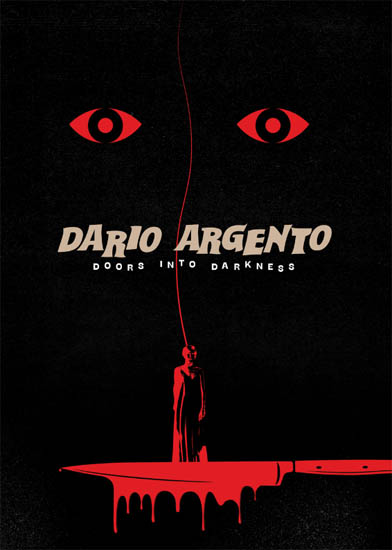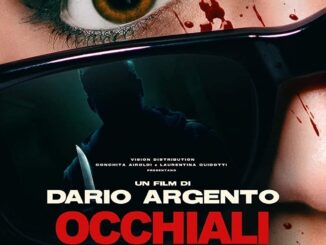
Following hugely successful tributes to directors including Michelangelo Antonioni, Federico Fellini and Pier Paolo Pasolini, the BFI and Cinecittà join forces once again and have announced DARIO ARGENTO: DOORS INTO DARKNESS, a new month-long season taking place from 1-30th May 2023 at BFI Southbank. For over five decades, Dario Argento has produced some of horror’s most beautifully nightmarish imagery – from the sleek, stylish shocks of his hugely influential crime thrillers, through to the gothic phantasmagoria of his occult horrors, and everything in between. Audiences will be able to hear about Argento’s long and storied career during Dario Argento in Conversation on 12 May 2023, as well as during introductions and Q&As that Argento will give alongside screenings of some of most iconic films.
The season will feature the UK-premieres of 17 brand-new 4K restorations, courtesy of season partner Cinecittà, including his soaring debut THE BIRD WITH THE CRYSTAL PLUMAGE (1970), sophomore whodunit THE CAT O’ NINE TAILS (1971), Freudian nightmare DEEP RED (1975), the gamechanging masterpiece SUSPIRIA (1977), the icy meta-giallo TENEBRAE (1982), his only feature-length American production TRAUMA (1993), and many more. A selection of Dario Argento’s films will also be available to subscribers to BFI Player, allowing audiences UK-wide to rediscover the work of this Master of Horror, while a video essay introducing the season called Strange Phenomena will also be available to watch on BFI YouTube from 17 April 2023.
Michael Blyth, Senior Film Programmer, BFI Festivals, and curator of Dario Argento: Doors Into Darkness, said: “Unquestionably one of the most influential names in the history of horror cinema, there is no other filmmaker who crafts worlds as exquisitely styled and nightmarishly surreal as Dario Argento. It is a pleasure to collaborate with Cinecittà on this celebration of his groundbreaking work, and to welcome him to BFI Southbank during the season. Rarely has terror looked so beautiful.”
Camilla Cormanni and Paola Ruggiero, Cinecittà, said: “We are proud to present in London, thanks to the well established collaboration with the British Film Institute, the retrospective dedicated to Dario Argento, one of the cult directors of Italian cinema. Creator of a genre that mixes psychological thriller, mystery and horror with splatter notes, Argento has created artworks where visionary power, aesthetic research, and an almost maniacal attention to photography and sound, have represented the distinctive features of his inimitable talent. We are very happy to have given back to the audiences 17 of the director’s films to their original glory, thanks to a meticulous digital restoration work. It is an honour for Cinecittà to celebrate a living author who continues, with his art, to be honoured and emulated by many fans all over the world”.
Dario Argento: Doors Into Darkness @ BFI Southbank May 2023
Don’t miss the BFI’s tribute to the Italian horror maestro.
To enjoy 2 for 1 tickets, simply quote DARKNESS241
FULL PROGRAMME DETAILS:
While Mario Bava’s formative 1963 murder mystery THE GIRL WHO KNEW TOO MUCH set the giallo blueprint, Argento’s soaring debut, THE BIRD WITH THE CRYSTAL PLUMAGE (1970), about an American in Rome who fears for his life after witnessing an attempted murder in an art gallery, crystallised the sub-genre’s popularity. Launching Argento to international stardom and gaining him several Hitchcock comparisons along the way, the film is a veritable checklist of the visual and thematic obsessions that he would return to throughout his career. With investors keen to cash in on his debut’s success, Argento was rushed into production on his sophomore whodunit, THE CAT O’ NINE TAILS (1971), which concerns a reporter who teams up with a blind cruciverbalist to investigate a series of murders. With its intricate plot leaving little time for lavishly violent set-pieces, the film lacks the instant pizzazz of his best-loved work, but for the patient, it is an underrated treasure-trove of low-key excess and restrained perversion.
With its audacious visuals and crazy plot devices, FOUR FLIES ON GREY VELVET (1971) follows a musician who accidentally kills his stalker, only to be stalked by a witness to the murder and is a stepping stone between the relative realism of his early work and the irresistible weirdness that followed. Notable for featuring a gay private eye, this was the first of several Argento films whose queer characters, while stereotypical, were not depicted as villains or predators typical of genre cinema at that time. Having claimed FOUR FLIES ON GREY VELVET to be his giallo swansong, Argento went back in time to 1848 for an uncharacteristically comedic tale of a thief and a baker who team up during the chaotic final days of the Italian Revolution in THE FIVE DAYS (1973). A box-office bomb in Italy, this spaghetti western-influenced melange of buddy movie, historical romp and political satire remains the director’s only non-horror/thriller, making it an absolute must for Argento completists.
After the commercial disappointment of THE FIVE DAYS, Argento reneged on his promise of retiring his black leather gloves, instead returning to his roots with DEEP RED (1975). Tinged with a touch of the supernatural and an incongruent side of sweet-natured humour, this Freudian nightmare follows David Hemmings’ British musician in Rome who, after witnessing the brutal murder of a psychic, teams up with a journalist (the first of many roles for Argento’s then-partner Daria Nicolodi) to find the killer. The screening of DEEP RED on 13 May will be followed by a Q&A with Dario Argento.
While DEEP RED saw Argento introduce a hint of the uncanny into his familiar pulpy universe, his gamechanging follow-up, SUSPIRIA (1977), was a no-holds-barred freefall into the fantastic. It follows an American ballet student who uncovers the terrifying truth about the prestigious German dance academy she attends. Freed from the plot-driven shackles of the gialli, SUSPIRIA is a defiantly illogical chromatic phantasmagoria, enveloping the viewer like a fever dream from which they cannot wake. The screening of SUSPIRIA on 12 May will be introduced by Dario Argento. Relocating from Germany to New York, the spiritual sequel to SUSPIRIA – INFERNO (1980) – sees an Italian student uncover an ancient coven while investigating his sister’s disappearance. With a near-incomprehensible plot, INFERNO defiantly prioritises form over content, playing out like a series of exquisitely crafted, yet bafflingly unconnected, set-pieces. Too avant-garde for conventional scares, it plunges viewers into labyrinth of horror that will be maddening to some, terrifying to others. Twenty-seven years after putting Mater Tenebrarum in her place, Argento completes his Three Mothers saga with MOTHER OF TEARS – THE THIRD MOTHER (2007), tying up horror’s biggest loose end. Forsaking the kaleidoscopic hues of SUSPIRIA and INFERNO, this story of a student inadvertently instigating apocalyptic chaos after unleashing the final sorceress from an ancient urn marks a stylist departure from its predecessors, but shares a nightmarish perversity and histrionic delirium befitting of the trilogy.
In TENEBRAE (1982), a best-selling American crime writer, upon arriving in Rome, learns that someone is pillaging his latest novel for murderous inspiration. With a brutalist, almost futuristic aesthetic, this icy meta-giallo was a stark departure from the Technicolor excess Argento had become known for. Under its chilly veneer, TENEBRAE stands as one of his most personal films – a shrewd moment of introspection and a sly middle finger to those critics who condemned the violent nature of his work. The screening of TENEBRAE on 13 May will be introduced by Dario Argento. A teen attending a Swiss boarding school discovers that young women in the area are being murdered in PHENOMENA (1985), a film that bridged the gap between Argento’s two distinct cinematic worlds, resulting in a fully-fledged supernatural giallo that remains his most bizarre and utterly unhinged piece of work.
Inspired by his own failed production of Verdi’s Rigoletto, OPERA (1987) sees Argento in self-reflexive mode, interrogating the spectacle and consumption of violence as entertainment; thrust into the lead role of an avant-garde staging of Verdi’s Macbeth, an understudy finds herself stalked by a killer who forces her to watch his murders. Meanwhile the soundtrack, a discordant coupling of Verdi’s melancholic arias with thrashing heavy metal riffs, is a perfect aural metaphor for a filmmaker always balanced on a knife-edge between high and low art. Given OPERA was widely recognised as Argento’s loose interpretation of Gaston Leroux’s tale of murder and obsession, some may question why Argento chose to adapt this classic again a decade later. Argento’s THE PHANTOM OF THE OPERA (1998), however, takes such brazen liberties with the source material that fears of repetition are resolutely quashed, leaving in their wake a giddy Grand-Guignol gore-fest that could be insulting if it weren’t so utterly bonkers.
Originally conceived as a quartet of Poe adaptations, TWO EVIL EYES (1990) ultimately consisted of just two tales – George Romero’s THE FACTS IN THE CASE OF M. VALDEMAR and Argento’s THE BLACK CAT, the latter of which will screen in isolation in the season. Although the film was met with some disappointment, THE BLACK CAT is quintessential Argento and deserving of a spot alongside his best works. TRAUMA (1993) was Argento’s only feature-length American production (and first collaboration with daughter Asia), and is something of a curiosity. On paper, this story of a teenage girl who joins forces with her boyfriend to hunt down her parents’ killer sounds like classic Argento. Yet critics accused him of ‘dumbing down’ his European sensibilities, while simultaneously failing to capture a sense of place with his non-descript mid-western landscape. But while TRAUMA stands as a divisive work in the filmmaker’s canon, it remains a fascinating one.
In THE STENDHAL SYNDROME (1996), while hunting down a serial rapist-killer, Detective Anna Manni experiences the titular syndrome – a psychosomatic disorder wherein artworks of extraordinary beauty prompt abnormal physical and psychological responses. When her target takes advantage of her fugue state, the hunter becomes the hunted. Argento’s alluring meditation on artistic beauty is undercut by an ugly story of sexual violence, made all the more disturbing by his daughter playing the lead role. After the unpredictable experimentation of his 90s output, Argento’s first offering for the new decade, SLEEPLESS (2001), saw him gleefully pay homage to himself, crafting a sharply tuned throwback to his early thrillers. When a serial killer resumes work after a 17-year absence, a retired detective who previously worked the case is forced to do the same.
Quietly coaxing the gialli into the 21st century, THE CARD PLAYER (2003) sees a police officer embroiled in a deadly game of video poker with a devious killer. Not only presaging the wave of internet-based horror films that emerged in the mid-2000s, Argento’s crime thriller came a year before SAW forced unsuspecting victims to compete in twisted tournaments of terror, popularising the torture porn subgenre in its wake. Meanwhile, DO YOU LIKE HITCHCOCK? (2005) was Argento’s retroactive response to a post-SCREAM meta-landscape. Originally intended as a pilot for a proposed Italian television series, Argento’s nimble nod to his cinematic mentor is an affectionate reimagining of REAR WINDOW (along with countless other references sprinkled throughout), in which a peeping film student inadvertently witnesses a murder in a neighbouring apartment.
At once comfortingly familiar, yet with the ability to surprise at any moment, Argento’s most recent film DARK GLASSES (2022) is a deliciously illogical blend of vicious bloodletting and sweet-natured sentimentality, in which a sex worker and a pre-teen boy must work together to outsmart a killer who has them in his sights. From its bravura opening sequence, this charmingly old-school concoction is a nostalgic treat for Argentophiles, displaying his effortless ability to balance moments of stark nihilism, camp excess and outré humour, often in the same scene.
Dario Argento: Doors into Darkness is at BFI Southbank from 1st-30th May 2023; selected titles will also be available to BFI Player subscribers*. Tickets are on sale to BFI Patrons and Champions on 3rd April 2023, BFI Members on 4th April 2023 and to the general public on 6th April 2023. Visit the BFI website for more info.
Co-produced by Cinecittà, Rome – Camilla Cormanni, Paola Ruggiero
Presented in collaboration with the Italian Cultural Institute and the Italian Embassy in London
Audience members aged 25 and under are able to buy tickets for BFI Southbank screenings (in advance or on the day) and special events and previews (on the day only), for just £3, through our ongoing ticket scheme for young audiences.





Be the first to comment